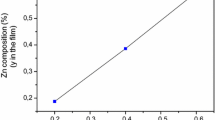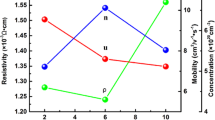Abstract
The a.c. conduction and the dielectric response were performed on bi-layers and quadri-layers of transparent Titania and Zinc white (i.e., TiO2/ZnO) thin film oxides of 100 nm thickness, deposited using an atomic layer deposition (ALD) system at 200 °C on silicon (100) substrates. The results show that Jonscher’s power law obeys a.c. conductivity (σac) with respect to the frequency dependence. The behavior of (σac) and the change of the frequency exponent (s) with temperature confirm the usage of correlated barrier hopping (CBH) mechanism for conduction. The dielectric response of the dielectric constant (ε′) and the dielectric loss (ε″) with increasing temperature as well as frequency are also analyzed. The consequences of the rise in the number of layers in the designed multilayer stacks are also investigated. Further, the presence of Meyer–Neldel relation in thermally triggered a.c. conduction in both thin-film samples are also reported. The results are explained using the cBΩ model and in terms of applicability for the corresponding relaxation time.









Similar content being viewed by others
Data availability
The data underlying this article are available in the article. The datasets generated during and/or analyzed during the current study are available from the corresponding author upon reasonable request.
References
K.C.L. Bauerfeind, J. Laun, M. Frisch, R. Kraehnert, T. Bredow, Metal substitution in rutile TiO2: segregation energy and conductivity. J. Elect. Mater. 51, 609–620 (2022)
H. Ji, J. Wei, D. Natelson, Modulation of the electrical properties of VO2 nanobeams using an ionic liquid as a gating medium. Nano Lett. 12, 2988–2992 (2012)
P. Kumbhakar, C.C. Gowda, P. Mahapatra, M. Mukherjee, K.D. Malviya, M. Chaker, A. Chandra, B. Lahiri, P. Ajayan, D. Jariwala, A. Singh, C. Tiwary, Emerging 2D metal oxides and their applications. Mater. Today 45, 142–168 (2021)
Y. Feng, X. Jiang, E. Ghafari, B. Kucukgok, C. Zhang, I. Ferguson, N. Lu, Metal oxides for thermoelectric power generation and beyond. Adv. Compos. Hybrid. Mater. 1, 114–126 (2018)
C.A.Y. Zhang, H. Guo, Y. Wang, Metal oxide-based supercapacitors: progress and prospectives. Nanoscale Adv. 1, 4644–4658 (2019)
T.R. Kumar, P. Prabukanthan, G. Harichandran, R. Senthil, T. Arunkumar, J. Theerthagiri, A simple, economical, and quick electrochemical deposition of rare-earth metal ion–doped ZnSe/FeS2 double-layer thin films with enhanced photoelectrochemical performance. Ionics 25, 6115–6122 (2019)
P. Prabukanthan, M. Sreedhar, G. Harichandran, T. Tatarchuk, K. Dinakaran, S. Uthayakumar, A. Younis, Physicochemical and electrocatalytic performance of chromium doped iron pyrite thin films. Phys. Chem. Sol Stat. 23, 134–143 (2023)
J. Tao, J. Jiang, S.-N. Zhao, Y. Zhang, X.-X. Li, X. Fang, P. Wang, W. Hu, Y.H. Lee, H.-L. Lu, D.-W. Zhang, Fabrication of 1D Te/2D ReS2 mixed-dimensional van der waals p-n heterojunction for high-performance phototransistor. ACS Nano 15, 3241–3250 (2021)
Z. Zhao, J. Tian, Y. Sang, A. Cabot, H. Liu, Structure, synthesis, and applications of TiO2 nanobelts. Adv. Mater. 27, 2557–2582 (2015)
J.M. Rzaij, A.M. Abass, Review on: TiO2 thin film as a metal oxide gas sensor. J. Chem. Rev. 2, 114–121 (2020)
Y.-C. Nah, I. Paramasivam, P. Schmuki, Doped TiO2 and TiO2 nanotubes: synthesis and applications. ChemPhysChem 11, 2698–2713 (2020)
J. Tao, H. Ma, K. Yuan, Y. Gu, J.-W. Lian, X.-X. Li, W. Huang, M. Nolan, H.-L. Lu, D.-W. Zhang, Modification of 1D TiO2 nanowires with GaOxNy by atomic layer deposition for TiO2@GaOxNy core–shell nanowires with enhanced photoelectrochemical performance. Nanoscale 12, 7159–7173 (2020)
P. Prabukanthan, G. Harichandran, Effect of 100 MeV O7+ ion beam irradiation on radio frequency reactive magnetron sputtered ZnO thin films. Mater. Sci. Semicond. Process. 16, 193–199 (2013)
J. Tao, H.-L. Lu, Y. Gu, H. Ma, X. Li, J.-X. Chen, W. Liu, H. Zhang, J. Feng, Investigation of growth characteristics, compositions, and properties of atomic layer deposited amorphous Zn-doped Ga2O3 films. Appl. Surf. Sci. 476, 733–740 (2019)
D.K. Sharma, S. Shukla, K.K. Sharma, V. Kumar, A review on ZnO: fundamental properties and applications. Mater. Today: Proc. 49, 3028–3035 (2022)
N. Mehta, Chap. 1, “Overview of coating deposition techniques,” in Tribology and Characterization of Surface Coatings. ed. by S. Ahmed, V.S. Dakre (Hoboken, Wiley-Scrivener, 2022), pp.1–32
T.J. Kunene, L.K. Tartibu, K. Ukoba, T. Jen, Review of atomic layer deposition process, application and modeling tools. Mater. Today: Proc. 62, 95–109 (2022)
H.C.M. Knoops, S.E. Potts, A.A. Bol, W.M.M. Kessels, Ch 27—atomic layer deposition in handbook of crystal growth edited by T. Kuech (Elsevier, Amsterdam, 2015), pp.1101–1134
J. Zhang, Y. Li, K. Cao, R. Chen, Advances in atomic layer deposition. Nanomanuf. Metrol. (2022). https://doi.org/10.1007/s41871-022-00136-8
H. Kim, H.-B.-R. Lee, W.-J. Maeng, Applications of atomic layer deposition to nanofabrication and emerging nanodevices. Thin Solid Films 517, 2563–2580 (2009)
R. Hussin, K. Choy, X. Hou, Enhancement of crystallinity and optical properties of bilayer TiO2/ZnO thin films prepared by atomic layer deposition. J. Nanosci. Nanotechnol. 11, 8143–8147 (2011)
W.-K. Wang, H. Wen, C.-H. Cheng, C. Hung, W. Chou, W. Yau, P.-F. Yang, Y. Lai, Nanotribological properties of ALD-processed bilayer TiO2/ZnO films. Microelectron. Reliab. 54, 2754–2759 (2014)
S.S. Fouad, B. Parditka, A.E. Bekheet, H.E. Atyia, Z. Erdelyi, ALD of TiO2/ZnO mutilayers towards the understanding of optical properties and polarizability. Opt. Las. Tech. 140, 107035 (2021)
A. Amini, M.S. Zakerhamidi, S. Khorram, Treatment of the ZnO and TiO2 thin films by electric field in plasma sheath to improve the metal-dye electronic coupling in dye-sensitized solar cells. Surf. Interfaces 23, 101028 (2021)
H.S. Varaprasad, P.V. Sridevi, M.S. Anuradha, Optical, morphological, electrical properties of ZnO-TiO2-SnO2/CeO2 semiconducting ternary nanocomposite. Adv. Powder Technol. 32, 1472–1480 (2021)
H. Zakaa, B. Parditka, Z. Erdelyi, H.E. Atyia, P. Sharma, S.S. Fouad, Investigation of dispersion parameters, dielectric properties and opto-electrical parameters of ZnO thin film grown by ALD. Optik 203, 163933 (2020)
P.K. Singh, S.K. Sharma, S.K. Tripathi, D.K. Dwivedi, Study of dielectric relaxation and thermally activated a.c. conduction in multicomponent Ge10 – xSe60Te30Inx (0 ≤ x ≤ 6) chalcogenide glasses using CBH model. Res. Phys. 12, 223–236 (2019)
E.G. El-Metwally, N.A. Hegab, M. Mostfa, The ac conduction mechanism and dielectric relaxation behavior of amorphous Te81Ge15Bi4 chalcogenide glass thin films. J. Mater. Sci. : Mater. Electron. 33, 12384–12396 (2022)
A. Sharma, N. Mehta, Study of dielectric relaxation and thermally activated a.c. conduction in lead-containing topological glassy semiconductors. RSC Adv. 7, 19085–19097 (2017)
Y.H. Elbashar, A.M. Badr, H.A. Elshaikh, A.G. Mostafa, A.M. Ibrahim, Dielectric and optical properties of CuO containing sodium zinc phosphate glasses. Proc. Appl. Ceram. 10, 277–286 (2016)
M.P. Weides, J.S. Kline, M.R. Vissers, M.O. Sandberg, D.S. Wisbey, B.R. Johnson, T.A. Ohki, D.P. Pappas, Coherence in a transmon qubit with epitaxial tunnel junctions. Appl. Phys. Lett. 99, 262502 (2011)
A. Hashemi, A. Bahari, S. Ghasemi, Synthesis and characterization of cross-linked nanocomposite as a gate dielectric for p-type silicon field-effect transistor. J. Electron. Mater. 47, 3717–3726 (2018)
A. Bahari, A. Mahya Ghovati, Hashemi, Studying of SiO2/capron nanocomposite as a gate dielectric film for improved threshold voltage. Appl. Phys. A 125, 257 (2019)
M. Shahbazi, A. Bahari, S. Ghasemi, Structural and frequency-dependent dielectric properties of PVP-SiO2-TMSPM hybrid thin films. Org. Electron. 32, 100–108 (2016)
M. Shahbazi, A. Bahari, S. Ghasemi, Studying saturation mobility, threshold voltage, and stability of PMMA-SiO2-TMSPM nano-hybrid as OFET gate dielectric. Synth. Metals 221, 332–339 (2016)
A.K. Jonscher, The ‘universal’ dielectric response. Nature 267, 673–679 (1977)
A.K. Jonscher, A new understanding of the dielectric relaxation of solids. J. Mater. Sci. 16, 2037–2060 (1981)
F. Abdel-Wahab, Signature of the Meyer–Neldel rule on the correlated barrier-hopping model. J. Appl. Phys. 91, 265 (2002)
F. Abdel-Wahab, The normal and inverted Meyer-Neldel rule in the ac conductivity. Turk. J. Phys. 28, 133 (2004)
S.R. Elliot, A theory of a.c. conduction in chalcogenide glasses. Philos. Mag. 36, 1291–1304 (1977)
K. Shimakawa, On the temperature dependence of ac conduction in chalcogenide glasses. Philos. Mag. B 46, 123 (1982)
J.C. Dyre, The random free-energy barrier model for ac conduction in disordered solids. J. Appl. Phys. 64, 2456 (1988)
J.M. Hvam, M.H. Brodsky, Dispersive transport and recombination lifetime in phosphorus-doped hydrogenated amorphous silicon. Phys. Rev. Lett. 46, 371 (1981)
J.C. Dyre, A phenomenological model for the Meyer-Neldel rule. J. Phys. C 19, 5655 (1986)
J.C. Dyre, A phenomenological model for the Meyer-Neldel rule: erratum. J. Phys. C 21, 2431 (1988)
N. Chandel, N. Mehta, Explanation of Meyer–Neldel rule in the thermally activated a.c. conduction in some chalcogenide glasses using correlated barrier hopping model. J. Mater. Sci. 47, 6693–6698 (2012)
A. Kumar, N. Mehta, Universality of Meyer-Neldel relation: case study of thermally activated a.c. conduction under laser irradiation. J. Phys. Chem. Sol. 121, 49–53 (2018)
M.I. Mohammed, S.S. Fouad, N. Mehta, Dielectric relaxation and thermally activated a.c. conduction in (PVDF)/(rGO) nano-composites: role of rGO over different fillers. J. Mater. Sci.: Mater. Electron. 29, 18271–18281 (2018)
Acknowledgements
The authors are grateful to the department of solid-state physics in the Faculty of Science and Technology at the University of Debrecen for providing the preparation and structural characterization facilities. Also sincere thanks to the Physics department in the Faculty of Education at Ain Shams University for providing all the experimental facilities for the optical measurements, according to the agreement between the coordinator Prof. Suzan Fouad (Faculty of Education, Ain Shams University), and the coordinator Prof. Zoltán Erdélyi (Faculty of Science and Technology, Debrecen University) through the project number TKP2021-NKTA-34 has been implemented with the support provided by the National Research, Development, and Innovation Fund of Hungary, financed under the TKP2021-NKTA funding scheme.
Funding
This study was supported by National Research, Development, and Innovation Fund of Hungary (Grant No. TKP2021-NKTA-34).
Author information
Authors and Affiliations
Contributions
BP, EB, and ZE synthesized thin-film samples and contributed to the formal analysis. SSF and HEA produced experimental data. NM contributed to the conceptualization and writing of the original draft, review and editing. SKP performed data analysis and plotted graphs.
Corresponding author
Ethics declarations
Conflict of interest
The present work has no conflict of interest.
Additional information
Publisher’s Note
Springer Nature remains neutral with regard to jurisdictional claims in published maps and institutional affiliations.
Rights and permissions
Springer Nature or its licensor (e.g. a society or other partner) holds exclusive rights to this article under a publishing agreement with the author(s) or other rightsholder(s); author self-archiving of the accepted manuscript version of this article is solely governed by the terms of such publishing agreement and applicable law.
About this article
Cite this article
Mehta, N., Fouad, S.S., Baradács, E. et al. Multilayer stack structural designing of titania and zinc white using atomic layer deposition (ALD) technique and study of thermally governed dielectric dispersion and conduction under alternating electric fields. J Mater Sci: Mater Electron 34, 708 (2023). https://doi.org/10.1007/s10854-023-10068-8
Received:
Accepted:
Published:
DOI: https://doi.org/10.1007/s10854-023-10068-8




